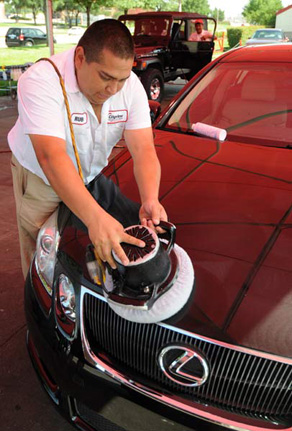How To Get the Highest Price
For Your Used Car
10 Car Care Tips to Help You Sell Your Used Car Fast
This list of Car Care tips is provided not only to help you sell your used car fast, but also be a checklist for your ongoing maintenance routine to help keep your car in tip top condition. It should be obvious that the better condition your car is in, the higher the price you can get for it. Consider this as investment advice. This is not a waste of time. It's not only good for your car, but for your driving safety and it has been proven that people will pay top dollar for a clean car in excellent mechanical condition. Even though some of these tips can be done right away, others, like oil change schedules require that you do proactive maintenance on your car's engine. All these tips will help you get the highest price, and most cash for your car, fast.
#1 |
I don't know how many times people have tried to sell their cars without even cleaning them and expect to get the best price for their used car. A lot of these cars smell like open ashtrays or worse- greasy seats and steering wheel, dusty and dirty exterior... you may be used to your own dirt, but your prospective buyer isn't. And if you are selling your car to a dealer, the less money he has to invest to make it ready for sale (like detailing) the more he can offer you. Be smart about this - would you want to test drive somebody else's dirty car? Make it all clean and shiny, and the engine, too. Make your prospective buyer want to just hand over the cash without haggling. That's the absolute first thing you need to do to get the highest price for your used car. |
#2
|
Your car's battery is the heart of your modern vehicle systems. Newer batteries are low maintenance and can be checked for their charge and condition ever few months. For older cars, check it every month. That means checking the cable terminals for corrosion and the cells for water level. If not too bad, clean the termnal ends with some coca cola and a battery brush, rinsing with clean water. If you need to add water to the cells to bring up to normal level, use distilled water only. Replace the battery when it becomes excessively dirty or will no longer hold a charge. Most battery installations are easy to reach, right under the hood in older, carbureted cars, or in a rectangular box at the forward end of the air intake assembly on modern fuel injected cars. Having a car or truck that starts right up and has a clean battery area will help you sell your car fast.
|
#3 |
Do a regular monthly inspection of your engine belts and hoses. They should always be flexible and in good condition. Any hose or belts showing dried out rubber that is frayed, glazed, or starting to show shredded threads should be replaced right away. If a belt breaks while you are driving, that could leave you stranded on the side of the road, usually out in the middle of nowhere. Also, always look at the metal clamps that hold the hoses in place. Make sure they are tight and not rusted or leaking. If a radiator hose looks bad or is excessively soft or hard, it should be replaced. Selling a used car fast is a lot easier when you take care of these small but very important details.
|
#4 |
Of all the tips that have helped me sell my used car fast, this one is the most important. Detailed attention paid to something as seemingly insignificant as checking your car's motor oil once a month can pay off big when it comes time to sell your car. Checking it means removing your dipstick mounted on the engine, wiping it clean with a paper towel or rag, then re-inserting the dipstick into the tube (the engine). Remove the dipstick a second time and inspect the fluid level. Your dipstick should have notches indicating if the level is low. Add oil if necessary. To maintain peak performance, your used car's oil should be completely drained and replaced every 5,000 miles or 6 months, depending on how much and how hard you drive your car. Refer to your owner's manual for oil change frequency. Remember to always replace the oil filter whenever the oil is changed. The absolute minimum is once a year, even if you only drive to church on Sundays. If your car has an oil-change indicator on the instrument cluster, don't exceed its warning.
And now a word about the different types of motor oil.Premium Conventional Oil- This grade of oil comes in all late model and newer cars. Most major brands have one for service level SL, available in several viscosities (degrees of oil thickness). Auto manufacturers often specify a 5W-20 or 5W-30 oil, particularly for those cars in colder climates- an alternate 10W-30 oil can also be used by cars driven in warmer or less extreme weather conditions. Newer cars can use weights as low as 0 (ex: 0W20) These ratings cover just about every used vehicle on the road. Full Synthetic Oil - Full synthetic oils are made for modern high-tech engines used in sports cars and German luxury autos. The oils of this type must pass stringent special tests and display better, longer range engine performance in several important areas, from viscosity index to protection against deposits. Synthetics are often favored in more extreme climates because of the way they flow better at low temperatures and keep peak lubricity at high temps. The high cost of synthetic compared to conventional oil means that only the most expensive and high performance autos are recommended to use this oil type. Lower performance autos are better served by conventional oils. As always, read and follow your owner's manual. Synthetic Blend Oil - These oils are a hybrid of synthetic oil mixed with conventional oil, and overall are formulated to provide protection for somewhat heavier loads and high temperatures. This type of oil, being less volatile, is good for use in warmer climates because it evaporates slower than conventional oil, which reduces oil loss and increases fuel economy. Synthetic blends are often a good alternative choice for those drivers who want a little better engine protection for less cost than a full synthetic oil. Higher Mileage Oil - 1990 model and later used vehicles are staying on the road longer than ever before. For those used car owners who intend to keep their autos a long time, there is also the option of using special oil formulated especially for higher-mileage cars. Almost two-thirds of the vehicles on the road have more than 75,000 miles on the odometer. High mileage oils are a little more costly than conventional motor oil because they have additives suited to the high mileage engine. Among these are properties that keep rubber engine seals supple thereby reducing leakage. Other properties account for metal wear in the engine. Too much engine wear or leakage and the oil pressure goes down dangerously, causing engine failure that could result in costly repair, maybe even more than your car is worth. If your vehicle is over 75-100,000 miles, the modest extra cost of "High Mileage" blends will really help to protect your investment. High mileage oils can be found at your local auto parts store and on the shelves at WalMart, Target, etc. National chains like Advance, O'Rielly's, Auto Zone and Pep Boys regularly stock many brands of this kind of motor oil for your high mileage used car.
|
#5 |
Check the brake fluid every 3-6 months. Pay attention to your car's brake master cylinder reservoir lid. If necessary, flip off the retainer clip and remove the lid or unscrew the plastic lid, depending on which type your vehicle has. Add needed fluid and check for possible leaks throughout the system. Pay special attention not to overfill the reservoir.
|
#6 |
Loose or broken exhaust clamps and supports can lead to bigger problems for your used car. Check for holes in muffler or pipes especially you people living along the coast should guard against rusted parts from all the damp, salty air. California's stringent smog laws require that your mufflers be in tip top shape. |
#7 |
|
#8 |
|
#9 |
|
#10 |
|
And Dont Forget These Car Care Tips: | |
|
|
|
|
|
|
Get Fast Cash For Your Car Now!
909-361-4641
or CLICK HERE for FREE online quote!

